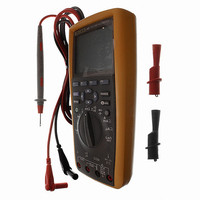FLUKE-289 Fluke Electronics, FLUKE-289 Datasheet - Page 48

FLUKE-289
Manufacturer Part Number
FLUKE-289
Description
DMM TRUE RMS 50000CNT W/BCKLGHT
Manufacturer
Fluke Electronics
Series
28xr
Type
Digital (DMM)r
Datasheet
1.FLUKE-289.pdf
(88 pages)
Specifications of FLUKE-289
Includes
Battery, Clips, Test Leads
Style
Handheld
Display Digits
4.5
Display Type
LCD, Bar Graph
Display Count
50000
Function
Voltage, Current, Resistance, Capacitance, Temperature, Frequency
Functions, Extra
Continuity, dB
Features
Data Logging, Hold, Memory, Min/Max/Ave
Ranging
Auto/Manual
Response
True RMS
Lead Free Status / RoHS Status
Not applicable / RoHS non-compliant
Other names
289
614-1062
614-1062
287/289
Users Manual
Measuring Current
Current is the flow of electrons through a conductor. To measure
current, you must open the circuit under test, then place the
meter in series with the circuit.
To measure ac or dc current, proceed as follows:
1.
38
To avoid damage to the Meter and possible injury,
never attempt an in-circuit current measurement
where the open-circuit potential to earth is greater
than 1000 V.
To avoid possible damage to the Meter or to the
equipment under test, check the meter’s fuses
before measuring current. See the Maintenance
section later in this manual. Use the proper
terminals, function, and range for your
measurement. Never place the probes across (in
parallel with) any circuit or component when the
leads are plugged into the current terminals.
When measuring current, the display will flash when
the input current exceeds 10 amps for the A terminal
and 400 mA for the mA/ A terminal. This is a warning
that current is approaching the fuse’s current limit.
Turn off power to the circuit. Discharge all high- voltage
capacitors.
XW Warning
W Caution
Note
2.
3.
4.
5.
6.
Insert the black lead into the COM terminal. Insert the red
lead in an input appropriate for the measurement range.
To avoid blowing the Meter’s 440 mA fuse, use the
mA/ A terminal only if you are sure the current is less
than 400 mA.
If you are using the A terminal, set the rotary switch to A.
If you are using the mA/ A terminal, set the rotary switch to
X for currents below 5000 A (5 mA), or A for
currents above 5000 A. See Figure 21 for test lead
connections and function selection. Refer to the “Input Alert
Feature” section for information on the alerts the Meter uses
when leads are not used correctly for current
measurements.
As shown in Figure 22, open the circuit path to be tested.
Touch the red probe to the more positive side of the break;
touch the black probe to the more negative side of the
break. Reversing the leads will produce a negative reading,
but will not damage the meter.
Turn on power to the circuit; then read the display. Be sure
to note the measurement unit given at the right side of the
display ( A, mA, or A).
Turn off power to the circuit and discharge all high-voltage
capacitors. Remove the Meter and restore the circuit to
normal operation.
Note










